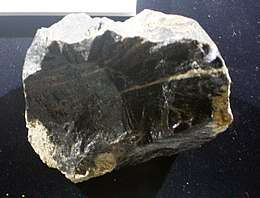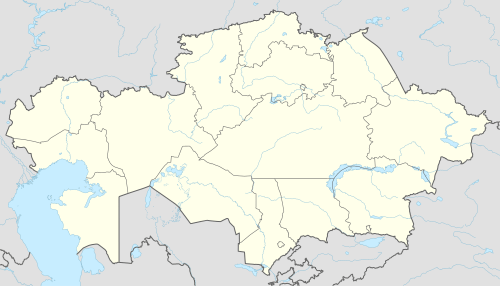Zhamanshin crater
Zhamanshin is a meteorite crater in Kazakhstan. It is 14 kilometres (8.7 mi) in diameter and the age is estimated to be 900,000 ± 100,000 years (Pleistocene). The crater is exposed at the surface.[1]
 Impact glass from the Zhamanshin impact site | |
| Impact crater/structure | |
|---|---|
| Confidence | Confirmed |
| Diameter | 14 km (8.7 mi) |
| Age | 900,000 ± 100,000 years Mid Pleistocene |
| Exposed | Yes |
| Drilled | Yes |
| Bolide type | Chondrite |
| Location | |
| Coordinates | 48°24′N 60°58′E |
| Country | Kazakhstan |
| State | Aktobe Region |
 Location of the crater in Kazakhstan | |
Description
It is believed that the Zhamanshin crater is the site of the most recent meteorite impact event of the magnitude that could have produced a disruption comparable to that of nuclear winter, but it was not sufficiently large to have caused a mass extinction.[2]
Preliminary papers in the late 1970s suggested either Elgygytgyn,[3] or Zhamanshin,[4] as the source of the Australasian strewnfield.
References
- "Zhamanshin". Earth Impact Database. Planetary and Space Science Centre University of New Brunswick Fredericton. Retrieved 2017-10-09.
- Essay "Impact Cratering on Earth", based on: R.A.F. Grieve, 1990, Impact cratering on the Earth, Scientific American, v. 262, 66-73.
- R.S. Dietz (1977), Elgygytgyn Crater, Siberia: Probable Source Of Australasian Tektite Field Meteoritics, June 1977, Vol 12, Issue 2, p. 145–157
- B.P. Glass (1979), Zhamanshin crater, a possible source of Australasian tektites? Geology, July 1979, v. 7, p. 351-353
This article is issued from Wikipedia. The text is licensed under Creative Commons - Attribution - Sharealike. Additional terms may apply for the media files.

